Last Updated on 11/19/2021 by Veronica Jones
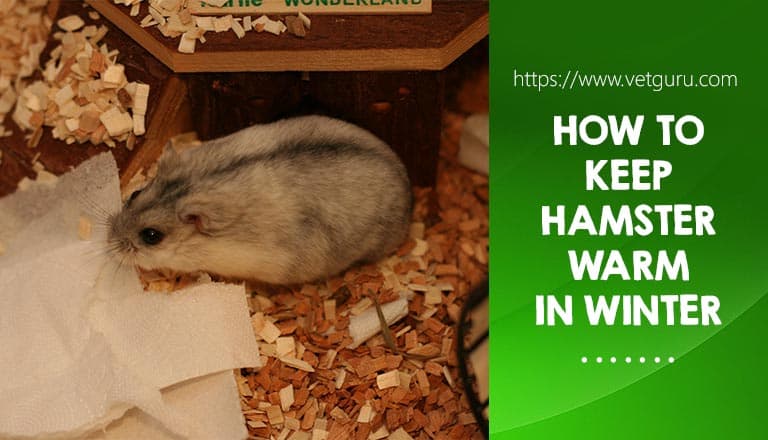
During the winter it is important to take steps to ensure that your hamster are warm and comfortable. Temperatures below 50 degrees Fahrenheit (or 10 degrees Celsius) can pose hazards to the well being of your small pet.
Very young or elderly small pets are at higher risk to viral or bacterial infections when the cold causes a suppressed immune system, and very cold temperatures can pose a threat of hypothermia for small pets.
Precautions can be taken to keep your pet warm and cozy during the winter months.
Habitat Location
During the colder months, your pet should be housed solely indoors. Animals that are kept outdoors in enclosures or hutches are at a much greater risk of cold weather hazards, and it is not advised to let your small pet play outside during the colder weather.
Be sure that your pet’s habitat is located in a draft-free area of your home in a room that will either be temperature controlled, or easier to temperature control with a space heater. If your home is hard to heat, placing your pet’s habitat in a bathroom, closet or other location that will be easier for you to insulate against the cold can make it easier to keep your pet warm.
Increase the Level of Bedding
For animals who are more likely to burrow, such as hamsters and mice, increasing the amount of bedding you use in the winter months can help your small pet make a warmer burrow for themselves. The type of bedding you use for your pet can also play an important role in keeping your pet warm.
Recycled cardboard bedding such as Carefresh Bedding of Kaytee Softsorb often hold a better nest structure for burrowing animals and can be a better choice than wood shavings or pellet type beddings.
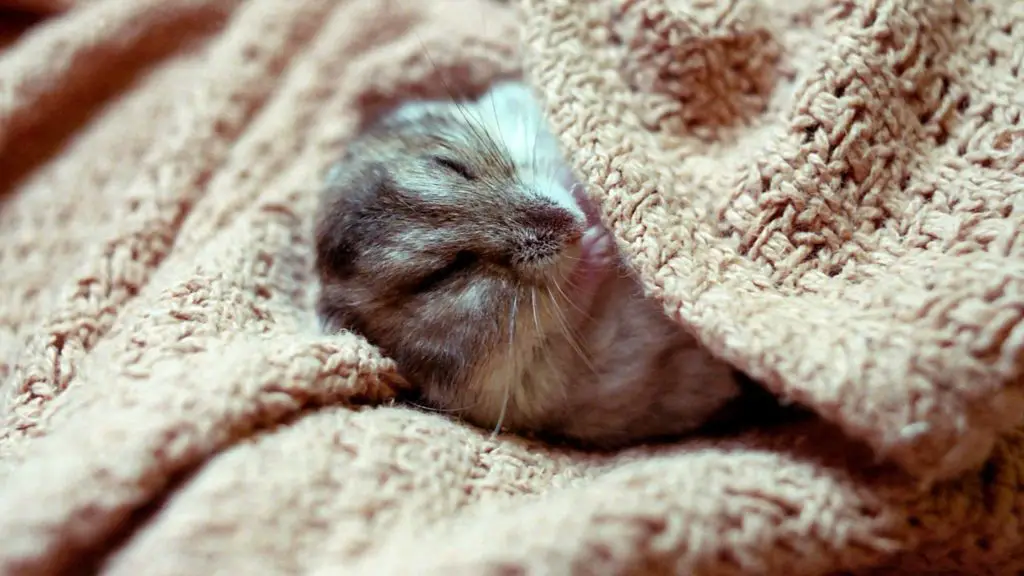
Nesting Materials and Containers
Providing a well-insulated nest box made of heavy wood, ceramic or thick plastic can also provide an insulated area for your pet to sleep. Be sure that your heavier nest box is placed in a secure area where your pet will not be able to overturn it or have it fall on them.
Providing extra nesting material such as unscented shredded paper towels, toilet tissue or facial tissue can be a good option for nesting hamsters, mice or rats. Smalls scraps of fleece can also provide good nesting material.
For larger species like rats, chinchillas, and rats, draping a piece of fleece fabric over another nest container (such as an igloo, tent or tunnel) can provide some extra insulation. Tube type hammocks also provide a great snuggle spot for rodents to curl up in.
Some bunnies will appreciate a cat or small dog bed with some extra padding. Some cat beds are sold with overhangs and provide a nice bed spot for a chilly bunny.
Temperature Control – Air Heating
Central Heating can keep everyone in the house comfortable, but some pet owners may not have the availability of central heating, or may not want to run it all of the time.
Space heaters can be purchased in a variety of models, although it is important to find a heater that has an automatic temperature control and one with a safety shut off should the heater be overturned or overheat when no one is around.
Never place a space heater directly pointing at your small pet’s cage, as you will run the risk of overheating your pet or in extreme cases, causing burns or other injuries to a pet on an overheated metal cage.
Remember to follow the manufacturer’s guidelines for each heater’s safety requirements, and place the heater several feet away from your small pet’s cage and aim to heat the room they are in rather than their specific environment.
Temperature Control – Cage Heaters
For those pets that are in cages, an under the cage heater can provide a good option for keeping your small pet warm.
Pad heaters that are sold for humans are not a suitable option, as they have an automatic shut off which can leave your pet in the cold during the night at the worst time.
Heaters sold for reptile cages do not have an automatic shut off and are self-regulating, and are a safe option. If you opt to use a heating pad, place the heating pad under only a portion (less then half) of your pet’s cage to allow them to get to a cooler area of the cage if they need to lower their temperature.
Care should be taken when warming a plastic habitat that the heat does not climb too high. You can supervise the heater during its first several hours on, and place your hand on the bedding of the cage to determine if enough warmth is coming through to your pet.
In some cases, it may be a good idea to elevate the cage 1-2 inches above the heating pad to be sure that no damage occurs to the heating pad or the bottom of the cage, particularly in heavier cages.
Blankets, Hammocks and Other Fabrics
Your bunny may appreciate a blanket or an extra soft rug to curl up on, while many rodents will love a tube or more enclosed hammock or pocket to sleep in. It is important to be sure the fabric you are using is a safe material for your small pets, who are prone to chewing on anything within their reach.
Blizzard and Alpine fleece can be good options, as when chewed they fall apart into pieces and do not have any strings that can become tangled around your pet’s limbs, or cause impactions inside your pet. Be sure you monitor your pet whenever you give them fabric to be sure it doesn’t look like they are ingesting the material.
A blanket draped over a cage can provide good insulation against drafts, just remember that your pet is more than likely to pull the fabric partially into the cage to chew on it, so don’t use any material you don’t mind having to throw out eventually!
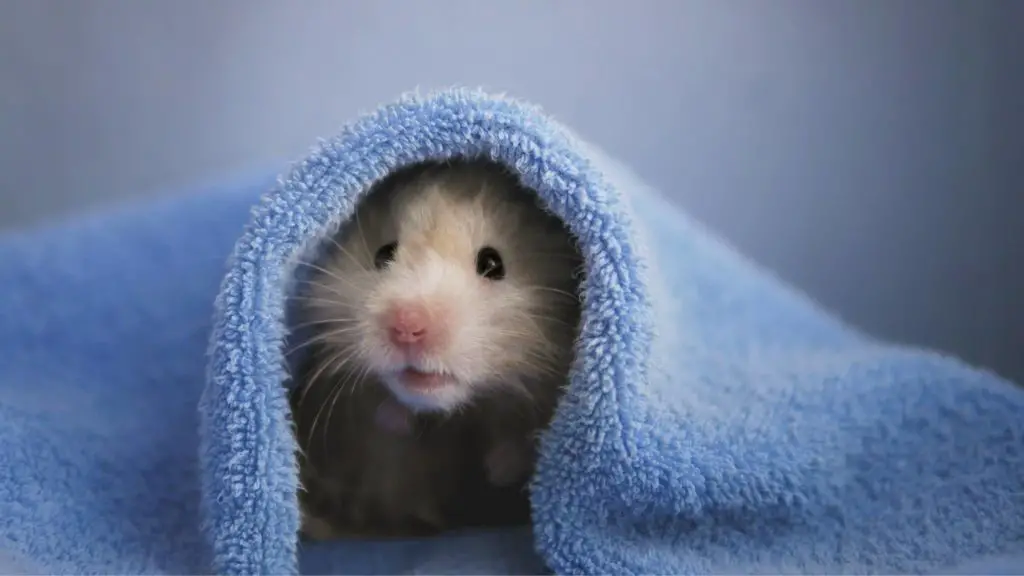
Hot Water Bottles and Microwaveable Warming Devices
You can place a hot water bottle or a microwavable rice (or other synthetic material) sock on the outside of your pet’s habitat, but it is not recommended to use these items inside the cage with your pet where they can be chewed on or soiled.
These methods are not reliable or useful for overnight periods of time when they will lose their heat and no one will be around to warm them back up but can be useful when you need to travel with your pet in the car before the heater warms up.
Hamsters at Risk
Syrian Hamsters are at a particular risk of hibernation during cold weather. Unlike wild animals that hibernate, Syrian Hamsters are not equipped to store enough water or extra calories during cold weather to survive a hibernation and will die if allowed to hibernate and not resuscitated immediately.
A hamster who has hibernated will have a slower respiration rate and will be unresponsive, and immediate steps must be taken to revive a hibernating hamster.
A hibernating hamster should immediately be removed to a warmer room and their temperature brought up gradually.
While the hamster is warming up, the human caretaker should rub gently but vigorously over the hamster’s body to stimulate blood flow and help revive the hamster.
Once the hamster is awake, a re-hydrating solution should be offered such as unflavored Pedialyte, or in a pinch, water sweetened with sugar to make it more enticing.
Soft foods should be provided while the hamster is warmed, and after the hamster has been resuscitated care should be taken to provide high-calorie foods and keep them taking in fluids to ensure a complete recovery.
A hamster that cannot be woken within a half an hour of being discovered should be immediately taken (in a warm carrier) to an emergency veterinarian who is familiar with the needs of hamsters.
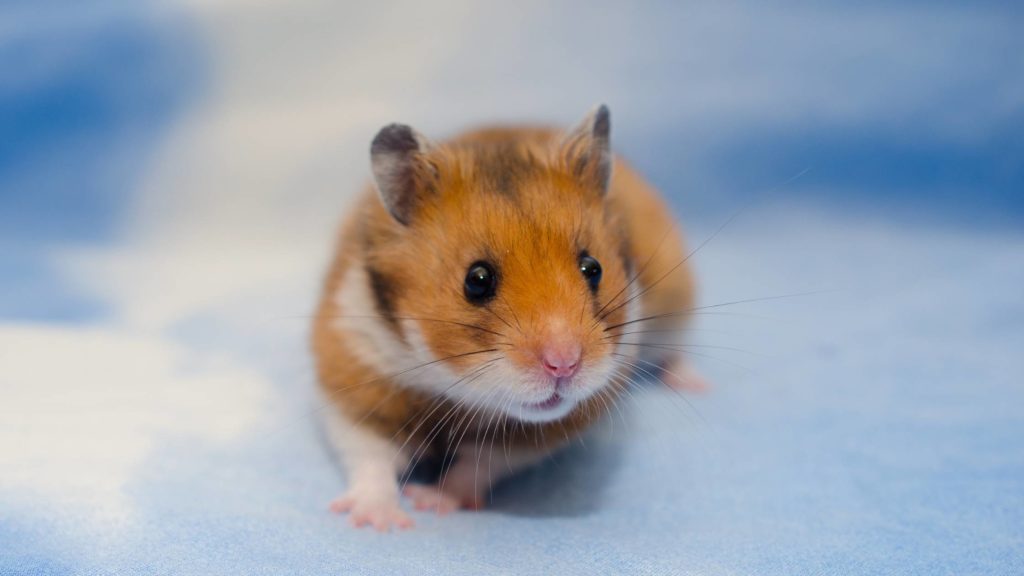
Is my room too cold for hamsters?
Your hamster should be kept in an environment between 65°F to 75°F. If temperatures drop lower than this, it could put your pet at risk of a number of health problems. The main danger of hamsters getting too cold is hibernation. Hibernation can cause dehydration and in extreme cases, hypothermic shock. Both of these could result in a fatality for hamsters.
Can I put a blanket in my hamster’s cage?
Blankets are a great way to trap heat and keep hamsters warm. They can be placed on the underside of your pet hamster’s cage to minimize coldness and provide extra insulation. A thick blanket on its own won’t be sufficient during the really cold months and cold temperatures. You will still need a heat source close by to keep your hamster toasty.
How do you know if your hamster is too cold?
Shivering, losing interest in food and water and acting lethargic are signs that your pet hamster may be feeling cold. Hamsters also sometimes have trouble breathing when they are cold so it’s important to warm him up quickly. You should also cover your hamster’s water bottle with a towel to keep it warm and prevent the liquid from freezing. Drinking cold water will make your pet hamster feel cold too. If the temperatures fall to extremely low, the water inside the water bottle may freeze. Your pet will then be able to drink and get dehydrated.
Can my hamster become ill from the cold?
Just like humans, hamsters and other small pets can catch colds, get runny noses and viral or bacterial infections. It’s important to monitor your pet’s behaviour, especially during the colder seasons to make sure your hamster’s immune system is functioning properly. Give your furry friend extra food, bedding and warmth during the winter. If you notice any signs such as a change in his fur or low energy, contact your veterinarian for advice. Keeping your hamster warm is essential to his survival.

Will changing my hamster’s diet help to keep him warm in the colder months?
Feeding your pet hamster food with a high percentage of fat and protein in cold weather can help keep them active and moving about in their hamster’s cage. Making them work for their meal is a good way to keep them active and warm. Try scattering their food around their cage in different places rather than in a bowl. Hiding food in cardboard tubes will stop them from getting bored or going into hibernation mode. Sunflower seeds, peanuts and avocado are healthy, fatty hamster-friendly foods. Giving your hamster warm milk is another way to warm up your hamster’s body heat.
How can I create a warm, hamster hiding place in the cage?
Hamsters love to hide and it helps them to control their body temperature and keep warm. It’s easy to create a hiding place for your pet hamster and add another layer of warmth to the cage. Simply use a small cardboard or well insulated nest box and grab some extra bedding to fill it with. Cut out an opening just large enough for your rodent to fit through. A hamster snug made from wood works well as it acts as a great heat insulator. Add some hay and your hamster hideout is complete.
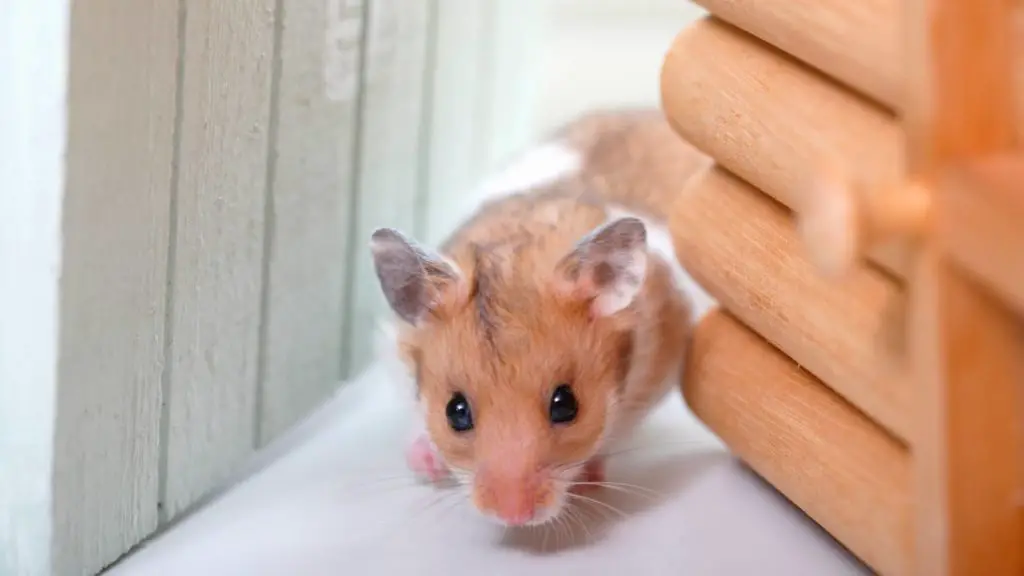
Can I put heating pads under my hamster’s cage?
Yes, adding a heating pad under your hamster’s cage is an effective way to keep your hamster’s environment consistently warm throughout the year. Invest in a high-quality heating mat that’s designed for rodents. Hamster heaters will usually come with an adhesive so you can stick the heating to a heat-protective surface under the cage.
How can I insulate the room my hamster is in?
Plastic window insulation and draft excluders could be enough to prevent your room from becoming too cold for your hamster. You can also add a space heater in the room where your rodent’s cage is located to help keep an ambient temperature.
Could moving my hamster to a smaller room help keep him warm?
It’s cheaper and easier to heat a small room, so moving your pet to a smaller room during the cold months could be a smart move. If you do move your hamster, make sure you don’t place the cage next to a drafty window or vents.
Which hamster cage is best to retain heat?
Hamster cages come in all shapes and sizes. A glass cage is the most effective way to protect your hamster from cold air and drafts. There’s no need to cover the cage with blankets or extra insulation, bedding will be enough to stop your pet from getting cold. You don’t need to put a glass cage near heat as this can make them get very hot, very quickly.
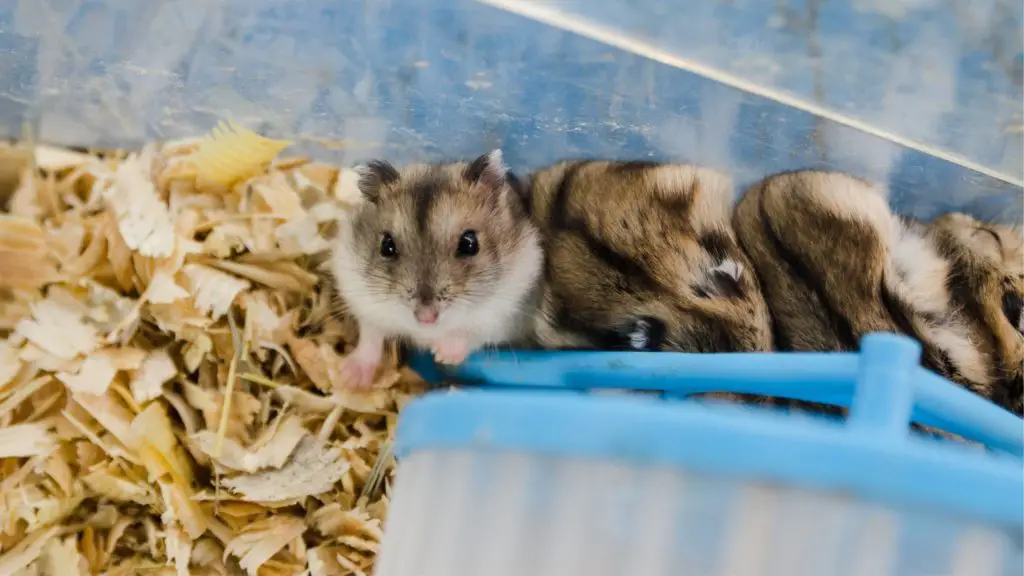
Can exercise help to keep my hamster warm?
It’s important that hamsters get daily exercise, not only to stay healthy but also to keep warm. Being physically active generates heat and can help keep their little bodies warm. Rodents are very active animals so won’t need much encouragement to run around and play. The best ways to exercise hamsters are:
Exercise wheel – a must-have for every hamster. Exercise wheels provide a great and entertaining activity for rodents that will help them burn off extra weight and keep warm.
Hamster ball – if you want to let your pet explore outside of his cage safely, a hamster ball is a great solution. The plastic will help keep your hamster warm as he works up a sweat running around.
Tunnels – in the wild, hamsters live in tunnels which is why they love being in them. You can use toilet paper rolls or buy hamster tubes to create a fun maze for your furry friend.
Climbing frames – as natural climbers, hamsters will have fun and stay fit by climbing. Ropes and twigs make great climbing frames and can be easily attached to your hamster’s cage.
Obstacle courses – toys, rope and sticks are great items that your hamster can jump or climb over. Switch up the course to keep your pet interested and make sure you have plenty of water available for your hamster to drink after exercising.

